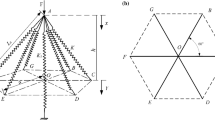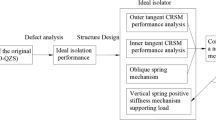Abstract
In the semiconductor manufacturing industry, the dynamic model of a controlled object is usually obtained from a frequency sweeping method before motion control. However, the existing isolators cannot properly isolate the disturbance of the inertial force on the platform base during frequency sweeping (the frequency is between 0 Hz and the natural frequency). In this paper, an adjustable anti-resonance frequency controller for a dual-stage actuation semi-active vibration isolation system (DSA-SAVIS) is proposed. This system has a significant anti-resonance characteristic; that is, the vibration amplitude can drop to nearly zero at a particular frequency, which is called the anti-resonance frequency. The proposed controller is designed to add an adjustable anti-resonance frequency to fully use this unique anti-resonance characteristic. Experimental results show that the closed-loop transmissibility is less than −15 dB from 0 Hz to the initial anti-resonance frequency. Furthermore, it is less than −30 dB around an added anti-resonance frequency which can be adjusted from 0 Hz to the initial anti-resonance frequency by changing the parameters of the proposed controller. With the proposed controller, the disturbance amplitude of the payload decays from 4 to 0.5 mm/s with a reduction of 87.5% for the impulse disturbance applied to the platform base. Simultaneously, the system can adjust the anti-resonance frequency point in real time by tracking the frequency sweeping disturbances, and a good vibration isolation performance is achieved. This indicates that the DSA-SAVIS and the proposed controller can be applied in the guarantee of an ultra-low vibration environment, especially at frequency sweeping in the semiconductor manufacturing industry.
摘要
在半导体制造业中, 被控对象的动态模型通常是在运动控制前通过扫频方法获得。然而, 现有隔离器不能很好隔离扫频时惯性力(频率在0 Hz和固有频率之间)对平台基座的干扰。本文提出一种用于双级驱动半主动隔振系统的可调反共振频率控制器。双级驱动半主动隔振系统具有显著的反共振特性, 在一个特定频率——即所谓反共振频率——振幅可降至接近零。本控制器的设计目的是增加一个可调的控制器反共振频率, 以充分利用这种独特的反共振特性。实验结果表明了本方案的可行性, 闭环传递率从0 Hz到初始反共振频率小于−15 dB。此外, 在附加反共振频率附近, 闭环传递率小于−30 dB, 可通过改变控制器参数实现附加反共振频率在0 Hz至初始反共振频率之间的调节。当平台基座受到脉冲扰动时, 使用本文提出的控制器, 有效载荷扰动幅度从4 mm/s衰减至0.5 mm/s, 降低87.5%。同时, 通过跟踪扫频干扰, 系统可实时调整反共振频率点, 获得良好隔振性能。这表明双级驱动半主动隔振系统和所提控制器可应用于保证超低振动环境, 特别是在半导体制造业的扫频工作中。
Similar content being viewed by others
References
Alujević N, Čakmak D, Wolf H, et al., 2018. Passive and active vibration isolation systems using inerter. J Sound Vib, 418:163–183. https://doi.org/10.1016/j.jsv.2017.12.031
Bai J, Daaoub A, Sangtarash S, et al., 2019. Anti-resonance features of destructive quantum interference in single-molecule thiophene junctions achieved by electrochemical gating. Nat Mater, 18(4):364–369. https://doi.org/10.1038/s41563-018-0265-4
Brennan MJ, 1997. Vibration control using a tunable vibration neutralizer. Proc Inst Mech Eng C J Mech Eng Sci, 211(2):91–108. https://doi.org/10.1243/0954406971521683
Bronowicki AJ, MacDonald R, Gursel Y, et al., 2003. Dual stage passive vibration isolation for optical interferometer missions. Proc SPIE 4852, Interferometry in Space, p.753–763. https://doi.org/10.1117/12.460731
Butler H, 2011. Position control in lithographic equipment. IEEE Contr Syst Mag, 31(5):28–47. https://doi.org/10.1109/MCS.2011.941882
Carre H, Doxtator RH, Duffy MC, 1982. Semiconductor manufacturing technology at IBM. IBM J Res Dev, 26(5):528–531. https://doi.org/10.1147/rd.265.0528
Coronado A, Trindade MA, Sampaio R, 2013. Frequency-dependent viscoelastic models for passive vibration isolation systems. Shock Vib, 9(4–5):862159. https://doi.org/10.1155/2002/862159
Davis CL, Lesieutre GA, 2000. An actively tuned solid-state vibration absorber using capacitive shunting of piezoelectric stiffness. J Sound Vib, 232(3):601–617. https://doi.org/10.1006/jsvi.1999.2755
Ding D, Torres JA, Pan DZ, 2011. High performance lithography hotspot detection with successively refined pattern identifications and machine learning. IEEE Trans Comput Aided Des Integr Circ Syst, 30(11):1621–1634. https://doi.org/10.1109/TCAD.2011.2164537
Franček P, Petošić A, Budimir M, et al., 2019. Electrical resonance/antiresonance characterization of NDT transducer and possible optimization of impulse excitation signals width and their types. NDT E Int, 106:29–41. https://doi.org/10.1016/j.ndteint.2019.05.005
Ismagilov FR, Papini L, Vavilov VE, et al., 2020. Design and performance of a high-speed permanent magnet generator with amorphous alloy magnetic core for aerospace applications. IEEE Trans Ind Electron, 67(3):1750–1758. https://doi.org/10.1109/TIE.2019.2905806
Ito S, Neyer D, Pirker S, et al., 2015. Atomic force microscopy using voice coil actuators for vibration isolation. Proc IEEE Int Conf on Advanced Intelligent Mechatronics, p.470–475. https://doi.org/10.1109/AIM.2015.7222578
Ito S, Unger S, Schitter G, 2017. Vibration isolator carrying atomic force microscope’s head. Mechatronics, 44:32–41. https://doi.org/10.1016/j.mechatronics.2017.04.008
Kamesh D, Pandiyan R, Ghosal A, 2012. Passive vibration isolation of reaction wheel disturbances using a low frequency flexible space platform. J Sound Vib, 331(6):1310–1330. https://doi.org/10.1016/j.jsv.2011.10.033
Lee KW, Noh YJ, Arai Y, et al., 2011. Precision measurement of micro-lens profile by using a force-controlled diamond cutting tool on an ultra-precision lathe. Int J Precis Technol, 2(2–3):211–225. https://doi.org/10.1504/IJPTECH.2011.039460
Li D, Wang B, Tong Z, et al., 2019. On-machine surface measurement and applications for ultra-precision machining: a state-of-the-art review. Int J Adv Manuf Technol, 104(1–4):831–847. https://doi.org/10.1007/s00170-019-03977-8
Liu H, Cui SP, Liu YW, et al., 2018. Design and vibration suppression control of a modular elastic joint. Sensors, 18(6):1869. https://doi.org/10.3390/s18061869
Matichard F, Lantz B, Mittleman R, et al., 2015. Seismic isolation of advanced LIGO: review of strategy, instrumentation and performance. Class Quantum Grav, 32(18):185003. https://doi.org/10.1088/0264-9381/32/18/185003
Nagaya K, Kurusu A, Ikai S, et al., 1999. Vibration control of a structure by using a tunable absorber and an optimal vibration absorber under auto-tuning control. J Sound Vib, 228(4):773–792. https://doi.org/10.1006/jsvi.1999.2443
Nelson PG, 1991. An active vibration isolation system for inertial reference and precision measurement. Rev Sci Instrum, 62(9):2069–2075. https://doi.org/10.1063/1.1142368
Niu JC, Zhao GQ, Hu XX, 2005. Active control of structural vibration by piezoelectric stack actuators. J Zhejiang Univ Sci, 6(9):974–979. https://doi.org/10.1631/jzus.2005.A0974
Niu WC, Li B, Xin T, et al., 2018. Vibration active control of structure with parameter perturbation using fractional order positive position feedback controller. J Sound Vib, 430:101–114. https://doi.org/10.1016/j.jsv.2018.05.038
Qiu ZC, Wang XF, Zhang XM, et al., 2018. A novel vibration measurement and active control method for a hinged flexible two-connected piezoelectric plate. Mech Syst Signal Process, 107:357–395. https://doi.org/10.1016/j.ymssp.2018.01.037
Qu D, Liu XD, Liu GT, et al., 2019. Analysis of vibration isolation performance of parallel air spring system for precision equipment transportation. Meas Contr, 52(3–4):291–302. https://doi.org/10.1177/0020294019836122
Song CS, Xiao Y, Yu CC, et al., 2018. H∞ active control of frequency-varying disturbances in a main engine on the floating raft vibration isolation system. J Low Freq Noise Vib Active Contr, 37(2):199–215. https://doi.org/10.1177/1461348417725944
Sun T, Huang ZY, Chen DY, et al., 2003. Signal frequency based self-tuning fuzzy controller for semi-active suspension system. J Zhejiang Univ Sci, 4(4):426–432. https://doi.org/10.1631/jzus.2003.0426
Suzuki Y, Abe N, 2013. Variable stiffness system for semi-active vibration control by frequency. Proc Conf of Kanto Branch, p.923–928.
Wang H, Li B, Liu Y, et al., 2019. Low-frequency, broadband piezoelectric vibration energy harvester with folded trapezoidal beam. Rev Sci Instrum, 90(3):035001. https://doi.org/10.1063/1.5034495
Xu JW, Yang XF, Li W, et al., 2020. Research on semi-active vibration isolation system based on electromagnetic spring. Mech Ind, 21(1):101. https://doi.org/10.1051/meca/2019048
Xu YF, Liao H, Liu L, et al., 2015. Modeling and robust H-infinite control of a novel non-contact ultra-quiet Stewart spacecraft. Acta Astronaut, 107:274–289. https://doi.org/10.1016/j.actaastro.2014.11.033
Yang BB, Hu YF, Vicario F, et al., 2017. Improvements of magnetic suspension active vibration isolation for floating raft system. Int J Appl Electromagn Mech, 53(2):193–209. https://doi.org/10.3233/JAE-150167
Yin SH, Xu ZQ, Yu JW, 2012. The composite ultra-precision processing technology for the small aspheric mould of stainless steel. Adv Mater Res, 497:176–179. https://doi.org/10.4028/www.scientific.net/AMR.497.176
Yong C, Zimcik DG, Wickramasinghe VK, et al., 2004. Development of the smart spring for active vibration control of helicopter blades. J Int Mat Syst Struct, 15(1):37–47. https://doi.org/10.1177/1045389X04039655
Zhang F, Shao SB, Tian Z, et al., 2019. Active-passive hybrid vibration isolation with magnetic negative stiffness isolator based on Maxwell normal stress. Mech Syst Signal Process, 123:244–263. https://doi.org/10.1016/j.ymssp.2019.01.022
Zhao C, Chen DY, 2008. Semi-active fuzzy sliding mode control for floating raft isolation system. Chin J Mech Eng, 44(2):163–169 (in Chinese). https://doi.org/10.3321/j.issn:0577-6686.2008.02.028
Zuo L, Slotine JJE, 2005. Robust vibration isolation via frequency-shaped sliding control and modal decomposition. J Sound Vib, 285(4–5):1123–1149. https://doi.org/10.1016/j.jsv.2004.09.014
Author information
Authors and Affiliations
Corresponding author
Additional information
Project supported by the National Natural Science Foundation of China (No. 51975160)
Contributors
Bo ZHAO and Jiubin TAN designed the research. Weijia SHI and Bingquan WANG processed the data. Bo ZHAO drafted the manuscript. Weijia SHI and Bingquan WANG helped organize the manuscript. Jiubin TAN revised and finalized the paper.
Compliance with ethics guidelines
Bo ZHAO, Weijia SHI, Bingquan WANG, and Jiubin TAN declare that they have no conflict of interest.
Rights and permissions
About this article
Cite this article
Zhao, B., Shi, W., Wang, B. et al. An adjustable anti-resonance frequency controller for a dual-stage actuation semi-active vibration isolation system. Front Inform Technol Electron Eng 22, 1390–1401 (2021). https://doi.org/10.1631/FITEE.2000373
Received:
Accepted:
Published:
Issue Date:
DOI: https://doi.org/10.1631/FITEE.2000373
Key words
- Semi-active vibration isolation
- Dual-stage actuation
- Dynamic vibration absorption
- Adjustable anti-resonance frequency controller




